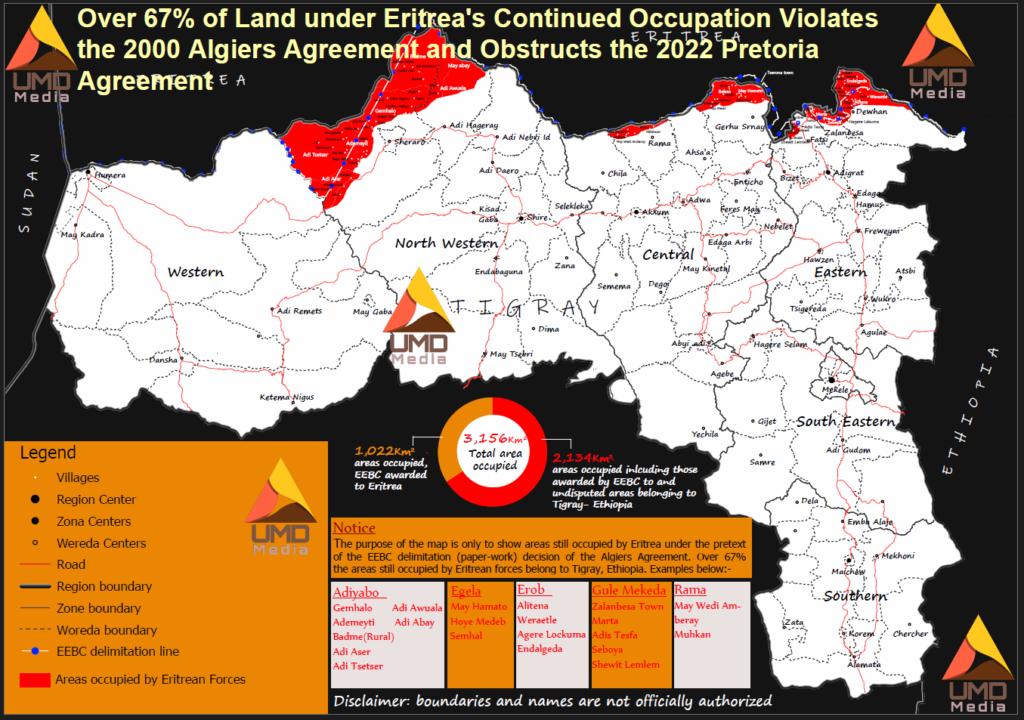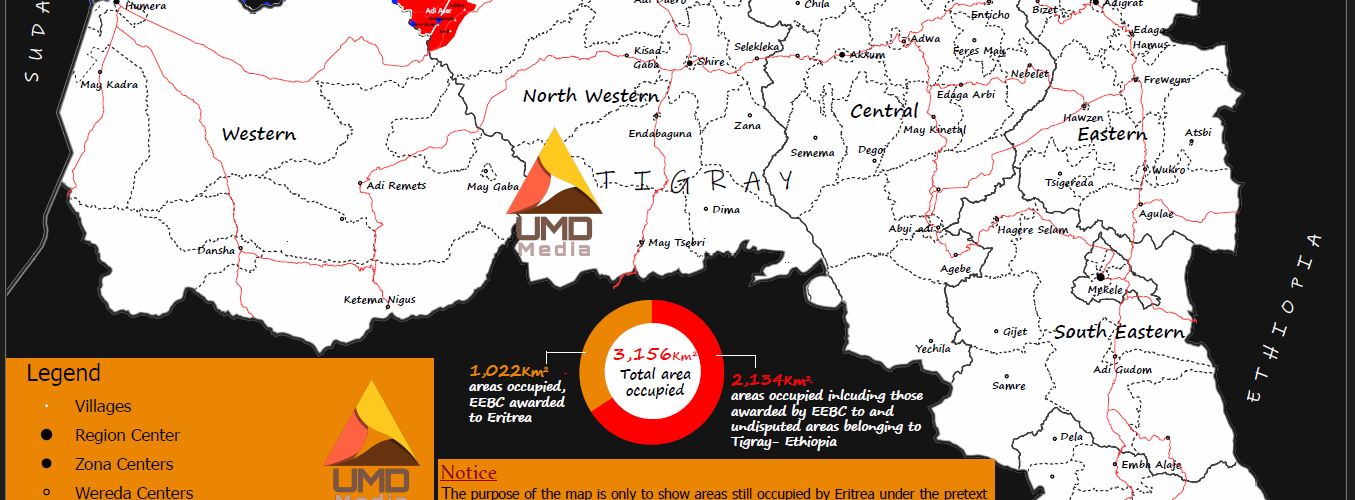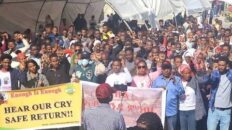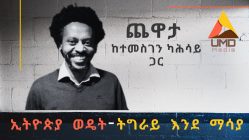May 25, 2024
- SUMMARY
Eritrea was an active part of the November 2020 – November 2022 genocidal war on Tigray. After the Pretoria Agreement signed in November 2022 between the Government of the Federal Republic of Ethiopia and the Tigray People Liberation Front (TPLF) Eritrea continues to illegally occupy a large swath of land amounting to at least 3 156 km2 land.
As a pretext for justifying the continued occupation, Eritrea points to the Algiers Agreement signed in 2000 that helped stop the Eritrea-Ethiopia war of May 1998 and led to the delimitation decision of the Ethiopia Eritrea Border Commission (EEBC) of April 2002 that made the on paper virtual demarcation of the border referred to as here as the EEBC line.
Eritrea’s participation in the war and continued occupation has violated the Algiers Agreement between The Government Of The Federal Democratic Republic Of Ethiopia and The Government Of The State Of Eritrea; and the Agreement on Cessation of Hostilities between the Government of the Federal Democratic Republic of Ethiopia and the Government of the State of Eritrea signed on June 18, 2000.
The total area occupied by Eritrea is composed of three categories:
i) areas north of the EEBC line but south of the pre May 1998 border awarded by the EEBC to Eritrea,
ii) areas south of the EEBC line and north of the pre May 1998 border awarded by the EEBC to Ethiopia,and
iii) areas south of the EEBC line and south of the pre May 1998 border deemed by the EEBC undisputed land belonging to Ethiopia.
The total of last two categories represent over 67% what continues to illegally occupied by Eritrea since November 2020 despite the Pretoria Agreement, the Nairobi Declaration, and the Algiers Agreement.
The over 67% ares that translates to at least 2 134 km2 included 1 971 km2 of undisputed Ethiopian territory and 163 km2 that was under Eritrea before May 1998 and awarded to Ethiopia following the EEBC ruling (Figure 1).

Figure 1. Areas under continued occpuation of Eritrean forces violating the 2000 Algiers Agreement and obstruction the 2022 Pretoria Agreement
Even the less than 33% of the occupied area needs to be honored as part of the implementation of the overall suite of agreements and rulings by first addressing the cornerstone provision of the Algiers Agreement, namely, Article 1, that stated The parties shall permanently terminate military hostilities between themselves. Each party shall refrain from the threat or use of force against the other.
Eritrea continues to breache this article of agreement since November 2020 deeming 100% of the continued occupation illegal.
Eritrea’s continued occupation is also hindering the fulfillment of the Pretoria Agreement and its offspring the Nairobi Declaration.
The Pretoria Agreement in Article 8.1 states that The ENDF shall be deployed along the international boundaries of Ethiopia;
While Article 8.2 underlines The ENDF shall safeguard the sovereignty, territorial integrity, and security of the country from foreign incursion and ensure that there will be no provocation or incursion from either side of the border.
Article 2d of the Nairobi Declaration signed by the two parties in Nairobi, Kenya on November 12, 2022 referring to Eritrean forces and regional forces such as the Amhara forces stated “Disarmament of heavy weapons will be done concurrently with the withdrawal of foreign and non-ENDF forces from the region.”
2) BACKGROUND
On 12 May 1998 Eritrean forces invaded areas “all either within undisputed Ethiopian territory or within territory that was peacefully administered by Ethiopia”.
From May 29 2000 to June 10, 2000, Eritrea and Ethiopia participated in “proximity talks” under the auspices of the African Union (then Organization of African Union) in Algiers. On June 18, 2000 the countries signed a cessation of hostilities agreement, committing themselves to a cease-fire and Ethiopia agreed to the redeployment of its forces back to areas under Ethiopian administration prior to May 1998.
On 12 December 2000, the Algiers Agreement with six pages and six articles was signed. Article 1 of the Agreement stipulated, The parties shall permanently terminate military hostilities between themselves. Each party shall refrain from the threat or use of force against the other.
While Article 2 stipulated The parties shall respect and fully implement the provisions of the Agreement on Cessation of Hostilities.
Articles 3-5 of the Algiers Agreement included the establishment for three institutional structures aimed at facilitating post-war cooperation between the parties:
i) an independent body appointed by the OAU to investigate into incidents leading up to and including May 6, 1998 that may have contributed to misunderstandings regarding the common border, including events in July and August 1997. This investigation was to be conducted by, Secretary-General, in consultation with the UN Secretary-General, Eritrea, and Ethiopia. The findings were to be communicated to the OAU and the two countries. This investigation never materialized.
ii) Eritrea-Ethiopia Boundary Commission, composed of five arbitrators of third-country nationality tasked with delimiting and demarcating the border based on relevant colonial treaties and international law. The commission, located in The Hague, received submissions from both parties and issued its delimitation decision in 2002. The agreement emphasized cooperation with the commission and affirmed that its determinations would be final and binding, with both parties obliged to respect the border established.
iii) Eritrea-Ethiopia Claims Commission responsible for adjudicating claims related to war-related injuries.
They also agreed to the deployment of a UN peacekeeping force of some 4,200 troops, the UN Mission to Ethiopia and Eritrea (UNMEE) within a twenty-five kilometer-wide temporary security zone (TSZ) just inside Eritrea along the Eritrean-Ethiopian border as it existed prior to May 1998. Eritrean forces would remain outside this zone though Eritrean police and local militia could return.
3) AGREEMENT ON CESSATION OF HOSTILITIES: repeatedly violated
UNMEE personnel responsible for monitoring the TSZ to ensure compliance with the ceasefire agreement conducted patrols and maintained observation posts within the zone after UN Security Council Resolution 1320 was adopted on September 15, 2000.
Since early 2004, Eritrea has enforced a series of restrictions on UNMEE. The initial restriction occurred in March 2004 when Eritrea closed the Asmara-Keren-Barentu road, which served as the main supply route for the Mission between Asmara and Sector West. More stringent measures were implemented, including limitations on the freedom of movement for UNMEE patrols in specific areas of the TSZ and neighboring regions, a ban on night patrols, and confining patrols to main supply routes. Eritrea prohibited UN helicopter flights in its airspace since October 2005. In December 2005, Eritrea expelled international staff of UNMEE from Canada, the Russian Federation, the United States of America, and European countries.
In September 2006, Eritrea began reducing fuel supplies to UNMEE to only half of its monthly requirements forcing the Mission to reduce its operational capacity. It ceased all fuel supplies to UNMEE on December 1, 2007, resulting in a crisis that necessitated the temporary relocation of UNMEE from Eritrea.
In his report to the Security Council on UNMEE on March 6, 2008, Secretary-General Ban Ki-moon condemned Eritrea’s obstruction of the temporary relocation of UNMEE peacekeepers as “unacceptable.” highlighting that Eritrea was bound by an agreement signed in 2000 to treat peacekeepers with respect and dignity, ensure their safety and security, and uphold their right to unrestricted movement for the execution of their mandated duties.
On Eritrea’s violation, special report of the Secretary-General on the UNMEE to the UN Security Council on 7 April 2008 stated:
“October 2006, when armed soldiers of the Eritrean Defence Forces, along with tanks and artillery, entered the Zone in Sector West. This incursion into the Zone was in violation of the security arrangements of the Agreement on Cessation of Hostilities. Despite protests by the United Nations, Eritrea not only retained, but steadily increased, its military presence inside the Temporary Security Zone. ”
The report added, “The military occupation by Eritrea of the Temporary Security Zone and the restrictions it has imposed on UNMEE are a violation of the Agreement on Cessation of Hostilities and have undermined the very basis of the Mission’s mandate.”
Prompted by severe restrictions imposed by Eritrea on UNMEE, along with the cessation of fuel supplies and other actions that rendered it impractical for the mission to fulfill its mandated duties and posed significant risks to the safety and security of UN personnel, on July 30, 2008, UN Security Council Resolution 1827 was unanimously passed that officially terminated the mandate of the UNMEE effective onJuly 31, 2008 after which the TSZ effectively ceased to exist as a monitored buffer zone.
4) DEMARCATION: “erection of pillars to bring the process to its natural conclusion” not done
Under the Algiers Agreement of 12 December 2000 the parties established the border commission to delimit and demarcate the border between them and agreed that “the delimitation and demarcation determinations of the Commission shall be final and binding” and agreed that “each Party shall respect the border so determined, as well as the territorial integrity and sovereignty of the other Party”.
The Commission delivered the delimitation decision of 13 April 2002. A 12 page statement of the Eritrea-Ethiopia Boundary Commission signed by Sir Elihu Lauterpacht CBE QC, President of the Commission on 27 November 2006 following its meeting in private session in The Hague on 20 November 2006 gave a detailed account of the timeline and activities conducted.
On July 8, 2002 the Commission issued the Demarcation Directions outlining the procedures for demarcation which were subsequently revised in November 2002, March 2003, and July 2003. The Commission established Field Offices in Asmara and Addis Ababa in November 2001 and in Adigrat in July 2002. A Chief Surveyor was appointed in October 2001, and a Special Consultant was appointed in May 2002 to provide technical advice and assistance. The Chief Surveyor began his duties in Asmara on November 15, 2001, and surveying staff were recruited to support him.
On January 24, 2003, in response to the Commission’s request for feedback on the draft 1:25,000 maps, Ethiopia submitted a memorandum expressing its views on the demarcation process. It stressed the importance of considering human and physical geography and advocated for adjustments to eliminate situations where villages were divided or roads were cut by the boundary.
On March 21, 2003, the Commission expressed its view that, unless expressly authorized by the Parties, it lacked the authority to alter the delimited boundary line except in cases of “manifest impracticability.”
Demarcation Instructions were issued on March 21 and August 22, 2003, and steps were taken to negotiate contracts for pillar construction and placement.
Certain parts of the boundary’s description in the Dispositif of the Delimitation Decision needed to be completed when the Commission received necessary information from the Special Consultant and Chief Surveyor, particularly regarding Tserona, Zalambessa, and Bure.
President of the Border Commission’s Statement of 27 November 2006 underlined the impact of Eritrea obstruction of UNMEE’s mandate in relation to the border commission’s activities that ,
“included the provision of necessary assistance to the Commission’s staff on the ground; in the Spring of 2006, Eritrea imposed far-reaching restrictions on UNMEE that had the effect of seriously impeding the resumption of operations by the Commission’s field staff; it rejected the Commission’s invitation to attend a meeting on 15 June 2006; instead, it sent a letter to the Commission stating that it was not prepared to continue its engagement, implying that the demarcation process was biased in favour of Ethiopia; in July 2006, it refused visas to the Commission’s field staff who had been instructed to return to Eritrea to reopen the Field Office there.”
On 7 April 2008, a special report of the Secretary-General on the United Nations Mission in Ethiopia and Eritrea to the UN Security Council stated the following regarding what had happened.
“Despite repeated attempts by the Eritrea-Ethiopia Boundary Commission during the next two years to advance the demarcation process, it could not break the impasse. Consequently, the Commission issued a statement on November 27, 2006, declaring that if the parties failed to agree on physically demarcating the boundary by placing pillars on the ground with the Commission’s assistance by the conclusion of November 2007, the boundary would automatically be considered demarcated based on the boundary points determined by the Commission using map coordinates. Additionally, the Commission stated that it would consider its mandate fulfilled. With no progress evident during the interim period, on November 30, 2007, the Eritrea-Ethiopia Boundary Commission confirmed that as of that date, the border was demarcated solely based on coordinates, commonly referred to as “virtual demarcation.”
Reacting to the ruling of November 2006 of the Commission months later Eritrea’s President, Isaias Afwerki, penned a letter on November 19, 2007, addressed to the President of the Eritrea-Ethiopia Boundary Commission, “as far as the ‘virtual demarcation’ is concerned, there are numerous questions that could be raised in regard to its meaning, content and implications”. The letter expressed “Eritrea’s acceptance of this procedure as an important step forward towards the demarcation on the ground”. Additionally, he emphasized that “virtual demarcation does not represent completion of the process”, and appealed to the Eritrea-Ethiopia Boundary Commission to continue their efforts “until erection of pillars to bring the process to its natural conclusion”.
Ethiopia, through a letter dated November 27, 2007, addressed to the President of the Eritrea-Ethiopia Boundary Commission from the Minister for Foreign Affairs, expressed that
“in Ethiopia’s view, these demarcation coordinates are invalid as they are not the product of a demarcation process recognized by international law”.
5) THE CLAIMS COMMISSION DECISIONS: left unimplemented and forgotten
The Eritrea-Ethiopia Claims Commission was created by Article 5 of the Algiers Agreement between the Government of the Federal Democratic Republic of Ethiopia and the Government of the State of Eritrea of December 12, 2000.
Under Article 5(1), it was stated that the “mandate of the Commission is to decide through binding arbitration all claims for loss, damage or injury by one Government against the other” related to the 1998–2000 conflict that “result from violations of international humanitarian law, including the 1949 Geneva Conventions, or other violations of international law.”
Beginning in 2001, the Commission held four rounds of hearings on the merits of both Parties’ claims between November 2002 and April 2005. Between July 1, 2003 and December 19, 2005, it issued four groups of Partial and Final Awards addressing claims of both Parties.
Reports Of International Arbitral Awards, Eritrea-Ethiopia Claims Commission – Partial Award: Jus Ad Bellum – Ethiopia’s Claims 1-8 of 19 December 2005 stated:
“The evidence showed that, at about 5:30 a.m. on May 12, 1998, Eritrean armed forces, comprised of at least two brigades of regular soldiers, supported by tanks and artillery, attacked the town of Badme and several other border areas in Ethiopia’s Tahtay Adiabo Wereda, as well as at least two places in its neighboring Laelay Adiabo Wereda. On that day and in the days immediately following, Eritrean armed forces then pushed across the flat Badme plain to higher ground in the east. Although the evidence regarding the nature of Ethiopian armed forces in the area conflicted, the weight of the evidence indicated that the Ethiopian defenders were composed merely of militia and some police, who were quickly forced to retreat by the invading Eritrean forces”
The Claims Commission found that Eritrea’s attack was in violation of Article 2(4) of the UN
Charter, specifically by resorting to armed force, and is liable to compensate Ethiopia, for the damages caused by that violation of international law of a total amount of US$174,036,520.
Reports Of International Arbitral Awards: Eritrea-Ethiopia Claims Commission – Final Award – Ethiopia’s Damages Claims dated 17 August 2009 stated:
“The Commission considered whether an award of compensation should be limited as necessary to ensure that the financial burden imposed on Eritrea would not be so excessive, given Eritrea’s economic condition, as to seriously damage its ability to meet its people’s basic needs. ”
6) CONCLUSION
The Ethiopia-Eritrea Border Commission faced significant challenges in its mission to demarcate the border between the two countries. Despite its efforts, the demarcation process was never completed. No compensation sanctioned by the Ethiopia-Eritrea Border Commission was ever paid.
Eritrea has repeatedly violated the no-use-of-force clause outlined in the Algiers Agreement and the Agreement on Cessation of Hostilities. The fragile peace was further undermined by the forced departure of the UNMEE and the staff of the Border Commission, which left a vacuum in peacekeeping and monitoring efforts.
To achieve sustainable peace in the region, a comprehensive and holistic approach is necessary that must involve a thorough examination of the missteps and failures that led to the deterioration of the peace process, and corrective measures must be implemented.
In particular, the plight of minority groups such as the Irob and Kunama, who reside in areas occupied by Eritrea, must be addressed. These communities continue to suffer due to the unresolved conflict and require specific attention to ensure their rights and livelihoods are protected and their dignities restored.Justice is crucial for fostering lasting peace and stability in the region.





